The Importance of Maintaining a Property
November 8, 2019

At HCS, we have undertaken many Building Surveys on residential properties, but looking back, there is one which stands out so much so that it was like looking at an open Building Pathology textbook!
This vacant house was an Auction Property which, due to the condition of the structure, meant that no viewings could be undertaken by the public. This immediately intrigued us!
We view many properties in a range of conditions; However, this Victorian terraced house gave a perfect example as to why maintaining a property is important and what can happen over time without TLC.
So, having provided our professional indemnity insurance and having signed a waiver, following the RICS Surveying Safely guidance notes, we put our best feet forward and began our venture.
Now, apart from the missing floorboards, collapsed ground floor windows, severely overgrown garden ‘Jungle,’ and the decorations being out of a 1960’s interiors catalogue, this property contained many other classic defects associated with a Victorian terraced property left in poor maintenance.
We have picked out a few of our favourites to share with you.
Severely Damaged and Leaning Chimney
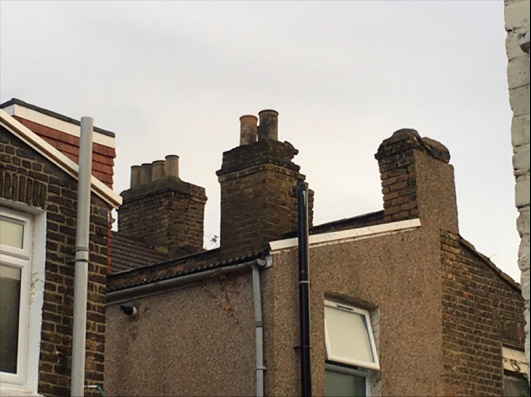
Chimneys are the most exposed element of a building, usually stuck without the protection of a roof or gutter to deflect the wind and rain.
As a result, they need regular maintenance. Neglecting to undertake this means that they are one of the first elements of a property to show damage.
The above image shows a number of areas of missing brickwork and a heavily leaning chimney to the rear of the property. The missing bricks were actually found in the first-floor bedroom, having come through the roof covering!
The damage above has been caused by years of neglect. As wind and rain begin to erode the mortar between bricks, the bricks become loose. Loose bricks affect the integrity of the chimney and may result on it falling on the heads of the occupants, or worse, your neighbours!
When damage is as serious as evidenced above, the option would be to carefully remove and rebuild compromised areas and any fix any damage to elements of the building surrounding it.
However, for most chimneys, an annual check from a surveyor to highlight any issues, and subsequently undertaking minor repointing and repairs using suitable mortar and removal of moss build up should be sufficient!
Damage to Ground and First Floor Timber Floor Structures from Moisture Ingress
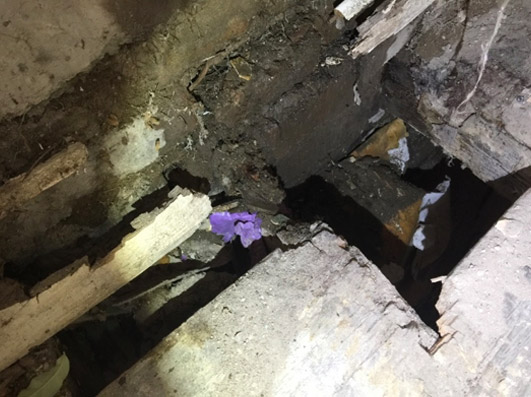
Timber floor structures are susceptible to damage from moisture. The picture to the right highlights damage caused by moisture entering from a broken window, over a number of years. In many cases this can have knock on effects even as drastic as having areas of the floor structure missing!
This type of damage was present in a number of areas within the property, and was caused by damage to roof coverings, broken windows, and full gutters. So, that broken slate, or even leaking gutter many people put off fixing until next year can have a serious effect if not remedied in good time.
Leaking Roof
The damage caused by the leaking roof covering not only caused damage to the ceilings seen in the photographs above, but also damaged the floor structure below.
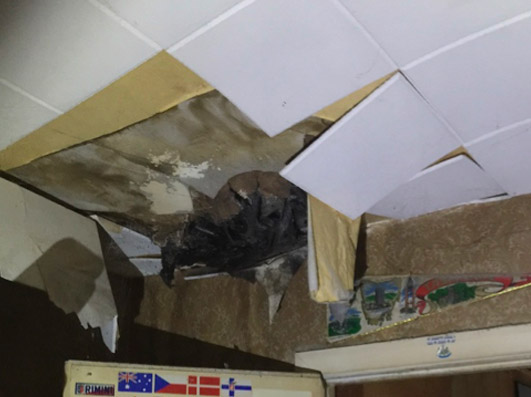
This picture shows an area of the property where bricks from the chimney shown earlier had damaged the coverings, leading to internal damage.
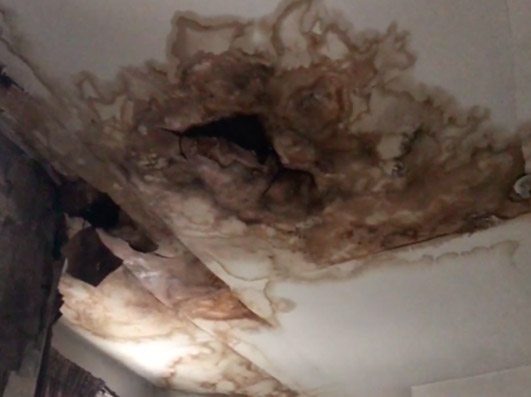
This picture shows damage from a broken tile, which worsened over the years, damaging both the ceiling structure and internal covering.
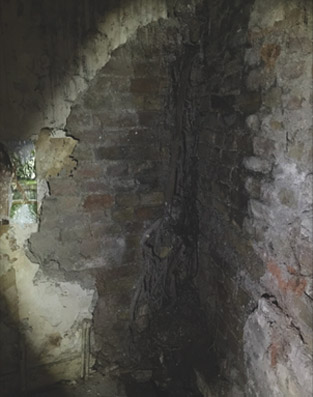 Maintenance of External Vegetation
Maintenance of External Vegetation
Many people care for indoor plants, however not those growing into the building structure!
For this property, we found external vegetation invading the external walls through a combination of a leaking gutter and damaged brickwork and mortar joints to allow vegetation to break into the internal areas of the property!
External vegetation growth had, over time, progressed through the external brickwork into the property. Large openings in the brickwork could be seen from inside the property showing entry of the vegetation growth.
This had led to a number of subsequent issues to the internal brickwork and finishes such as displaced brickwork, and damage to the structure, resulting in having to re-tie parts of the building together with structural bars, as we suggested to our client.
An invasive defect such as this can be combatted by regularly checking for leaking gutters, clearing vegetation and moss growth from inside gutters, and ensuring vegetation adjacent to the structure of a property is regularly maintained and cut back, especially climbing plants.
Remember, undertaking what seems like minor maintenance to that leaking gutter, cracked tile, or section of missing pointing will ensure that you have enjoyment of your property for years to come, instead of finding it falling down around your ears such as in this property!
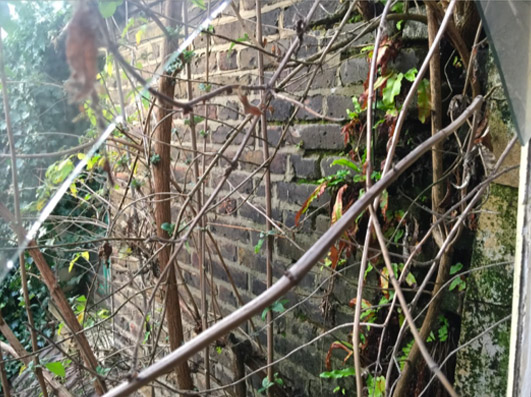
We hope that this article has provided an interesting read and demonstrated our eagerness to assist in surveying properties of all ages and conditions!
Should our services be of interest to you, be it a survey on a new or old property purchase, or even an inspection to confirm the condition of a roof covering, we would be happy to help.
Visit the ‘Contact Us’ page to voice your enquiry
Call or email us at:
- 020 3102 7701 (London)
- 01277 223594 (Shenfield, Brentwood, Essex)
- info@howecharteredsurveyors.co.uk